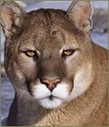EDITOR’S NOTE: Awareness and education about the wild place that we call home … recent reports of an incident that possibly involved a cougar and horses on Miami Foley Road prompted an email to our local ODFW office. The horses were seriously injured by something that chased them and had to be put down, it is not confirmed that it was a cougar, but local residents identified cougar tracks nearby. Since a cougar’s range can be 100 miles, everyone in the Nehalem Valley and throughout Tillamook County, should always be on alert, especially if you have livestock, small animals, and children. There are cougars, bears, bobcats, coyotes and other predators right in our “backyard” – we are in their territory. Here’s some helpful information about living and recreating in cougar country, and what to do if you have a face-to-face encounter with a cougar.
Oregon is home to more than 6,000 cougars, or mountain lions. While cougar sightings and encounters are rare, it is wise to educate yourself about the big cats.
Native to Oregon, cougars range throughout the state, the highest densities occur in the Blue Mountains in the northeastern part of the state and in the southwestern Cascade Mountains . Their primarily food source is deer, but they will also consume elk, raccoons, bighorn sheep, and other mammals and birds. Cougars are territorial animals and maintain home ranges of up to 100 miles. Most active at dawn and dusk, cougars are lone hunters. They are generally solitary animals, except for mothers who remain with kittens for about two years. While actual cougar sightings have increased, coyotes, bobcats and dogs are often mistaken for cougars. A cougar can be identified by its large size, cat-like appearance, consistent tan or tawny body color, and long tail. An adult cougar’s tail is nearly three feet long and a third to a half of its total length. Cougar tracks can be differentiated from dog tracks by paying attention to detail.
Report any cougar sighting or encounter to a local ODFW office, Oregon Dept of Fish & Wildlife, North Coast Watershed District, 4907 3rd St., Tillamook, 503-842-2741×18623, Oregon State Police, report to Tillamook County non-emergency at 503-815-1191, or the land manager if on public land.
Track Comparison
| COUGAR TRACKS
|
DOG TRACKS
|
|
|
Guidelines
If you live in cougar country:
- Learn your neighborhood. Be aware of any wildlife corridors or places where deer or elk concentrate.
- Walk pets during the day and keep them on a leash.
- Keep pets indoors at dawn and dusk. Shelter them for the night.
- Feed pets indoors.
- Don’t leave food and garbage outside.
- Use animal-proof garbage cans if necessary.
- Remove heavy brush from near the house and play areas.
- Install motion-activated light outdoors along walkways and driveways.
- Be more cautious at dawn and dusk when cougars are most active.
- Do not feed any wildlife. By attracting other wildlife, you may attract a cougar.
- Keep areas around bird feeders clean.
- Deer-proof your garden and yard with nets, lights, fencing.
- Fence and shelter livestock. Move them to sheds or barns at night.
If you recreate in cougar country:
- Be aware of your surroundings at all times.
- Leave your dog at home or keep it on a leash. Pets running free may lead a cougar back to you.
- Hike in groups. Make noise to alert wildlife of your presence.
- Keep children close to you. Teach them about wildlife.
- Keep campsites clean. Sleep 100 yards from cooking areas.
- Store food in animal-proof containers.
- Carry deterrent spray.
- Be cautious at dusk and dawn.
- Never feed any wildlife. Prey attracts predators.
- Do not approach any wildlife; stay at least 100 yards away.
- Steer clear of baby wildlife. Mother is likely nearby.
- Be alert when sitting quietly or stopping to rest.
- Be especially alert at dawn and dusk when cougars are most active.
- Be aware that animal calls and animal kills can attract a cougar.
If you encounter a cougar:
- Cougars often will retreat if given the opportunity. Leave the animal a way to escape.
- Stay calm and stand your ground.
- Maintain direct eye contact.
- Pick up children, but do so without bending down or turning your back on the cougar.
- Back away slowly.
- Do not run. Running triggers a chase response in cougars, which could lead to an attack.
- Raise your voice and speak firmly.
- If the cougar seems aggressive, raise your arms to make yourself look larger and clap your hands.
- If in the very unusual event that a cougar attacks you, fight back with rocks, sticks, bear or pepper spray, tools or any items available.
Here is a brochure with more information:




